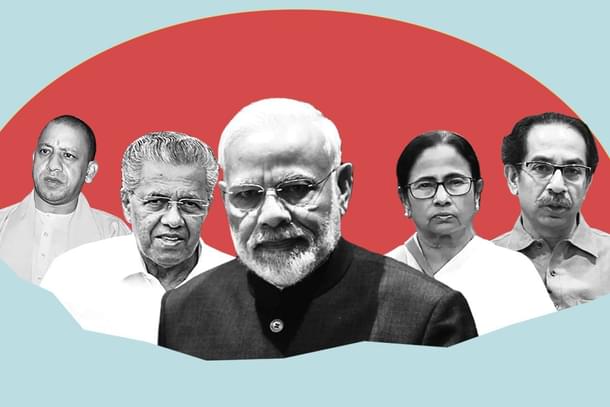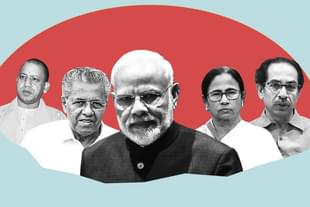Ideas
Indians Are Locked Inside Their Homes For Past One Month But No State Seems To Be Crushing The Curve
Arihant Pawariya
Apr 22, 2020, 06:12 PM | Updated Apr 23, 2020, 11:45 AM IST
Save & read from anywhere!
Bookmark stories for easy access on any device or the Swarajya app.


One-hundred-thirty-crore Indians have now completed a month in home quarantine. On the same day last month, the country observed Janata Curfew, a voluntary call by Prime Minister Modi requesting everyone to stay home.
In the evening, all the states announced their own lockdowns till 31 March. Two days later, national lockdown was put in place. All public transport — trains, flights, railways and buses came to a halt exactly a month back.
India had 400-odd cases of Covid-19 at that time. Today, the figure is above 20,000. This staggering growth has come when the nation has been observing extreme social distancing. Millions of daily wage labourers have lost their jobs. Thousands of people with health problems are on the edge as they can’t get regular treatment because hospitals are now completely focussed on Covid-19 alone.
Despite the nation going through this extremely tense and painful test, there is no stopping the rise in number of Coronavirus cases. As the graph below suggests, the curve of daily new cases is nowhere close to being flattened, forget about crushing it.

We have Tablighi Jamaat to thank for, for spoiling the whole country’s preparedness plans with its utterly irresponsible and reckless behaviour.
Even if one were to excuse the Jamaat for gathering in thousands at Markaz in Delhi, where foreigner Mullahs infected with Covid-19 spread the disease to others, how can one forgive its members for hiding from health authorities, spreading the infection in Muslim communities, which are leading to creation of massive virus clusters.
Had it not been for the Jamaat, the number of daily new cases would’ve peaked after two weeks of national lockdown and we would’ve succeeded in crushing the curve by this month’s end.
But given the present situation, it seems the country and the people will have to suffer longer.
It’s not all gloom and doom though. There are definitely some signs of hope. For instance, 46 per cent of the cases come from 18 top clusters (districts/cities). Around 400 districts are virus free now — 325 never reported a single case and over 60 have not reported a case for more than two weeks.
But as long as cases keep coming up, even if in small numbers, opening the country and restarting it will be difficult.
So, while the national numbers matter, they don’t tell us what’s happening in the states.
Implementation of lockdowns and success of containment efforts in outbreak clusters depend on how states go about doing their job.
Some small states have shown good promise. For instance, in Kerala, Haryana, Chhattisgarh, Assam, Chandigarh, Ladakh, Andaman and Nicobar Islands, Goa, Puducherry, Manipur, Arunachal Pradesh, the number of recovered patients now exceed the number of total confirmed cases — which is a good proxy of the pace at which the cases are increasing, which is very slow.
But what about top states which are chiefly responsible for increasing the country’s case load? Let’s see how they are doing.
1. Maharashtra, Gujarat, Uttar Pradesh and West Bengal
Moving average (6-day) has almost doubled in Maharashtra and Gujarat from an already high base since the second phase of lockdown started on 14 April.
Uttar Pradesh, where case load so far seemed to be under control, is on a similar path and moving average has increased from around 50 new cases to 100 new cases in just last eight days. No one is sure of the numbers coming from West Bengal. The Centre was forced to dispatch its team to find out what the state government is up to. But in this state too, the trajectory is going up for daily new cases. In all these four, flattening the curve should be a priority but it’s unlikely that this will happen anytime soon.


2. Telangana and Andhra erase gains
Before the start of the second phase of national lockdown, two states seemed to be on their way to crush the curve. Those were Telugu sisters Andhra Pradesh and Telangana but in the past eight days, six-day moving average is back to previous heights and the curve, which was starting to bend, has curved upwards again, thereby erasing crucial gains made in the week before.

3. New Delhi and Tamil Nadu — Small successes but too early to celebrate
Both Delhi and Tamil Nadu were hit badly by the Nizamuddin Markaz cluster. In both these states, moving average for fresh cases has come down, though slightly. It is too early to tell whether they can sustain and keep taking the curve towards zero or erase the gains like Andhra or Telangana.

4. Madhya Pradesh, Rajasthan And Karnataka — Momentarily Flat After Sudden Spikes
All the three states recently witnessed sudden increase in fresh cases. The sudden increase in Rajasthan and Madhya Pradesh was due to Jaipur and Indore cluster respectively. It seems they have stabled but it’s still too early to say anything conclusively.

In Karnataka, the government’s efforts had kept the score low, but after 14 April, it saw moving average rise substantially due to sudden reporting of new cases on 15, 16 and 17 April. It’s yet to be seen whether this was a one-time increase.

5. Kerala — only state which seemed to be crushing the curve but now doubts emerge
Until last week, conventional judgment was that Kerala is surely crushing the curve of new cases. Its moving average decreased from 20 daily cases to less than five in just two weeks. But Tablighi Jamaat could spoil the state’s plans. At least 284 people from Kerala who had participated in the Tablighi Jamaat convention in Nizamuddin in New Delhi are now at large and remain untraceable as their mobile phones are switched off. This is bound to give sleepless nights to the state administration.

What the data for top 12 states in number of total confirmed cases shows is that no state can claim with certainty that it will be able to crush the curve by 3 May, the end of the second phase of national lockdown.
The longer the states take to get the situation under control, the more will be the pain for their residents and the patience of the people locked inside their homes could start wearing thin.
They can’t be expected to remain inside for months. Even if with such few numbers, India takes months to come out of the lockdown, it will be a huge failure.
Every day costs thousands of crores of rupees to the economy. The states must do everything to quickly trace, test and isolate all the infected people as soon as possible.
Meanwhile, the 400-odd virus-free districts should open completely, paving the way for more than half of the country to heave a sigh of relief. India can’t afford a blanket national lockdown a day longer.
Arihant Pawariya is Senior Editor, Swarajya.





